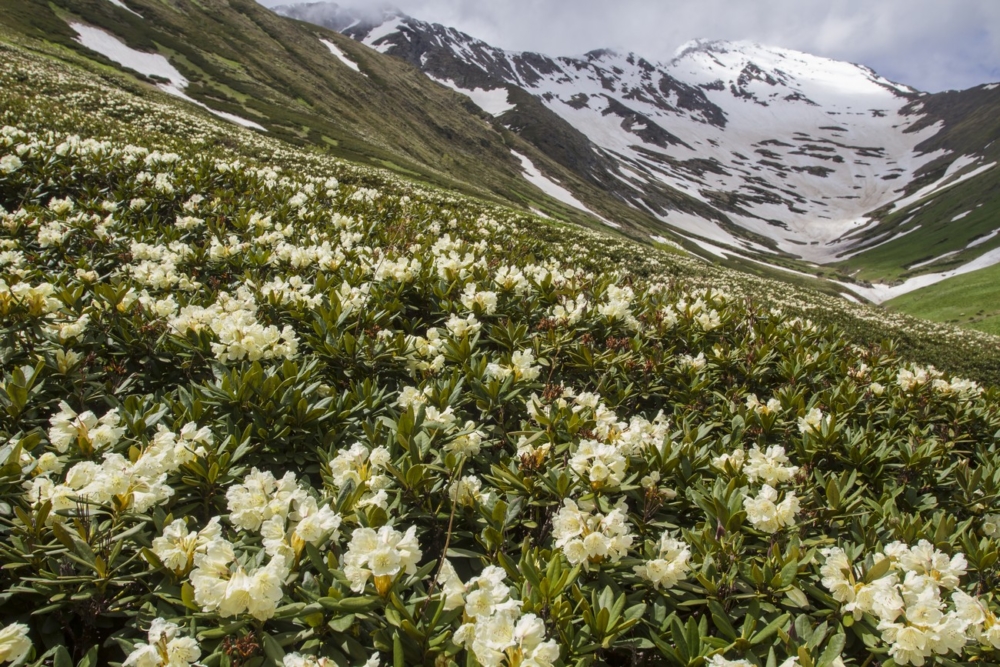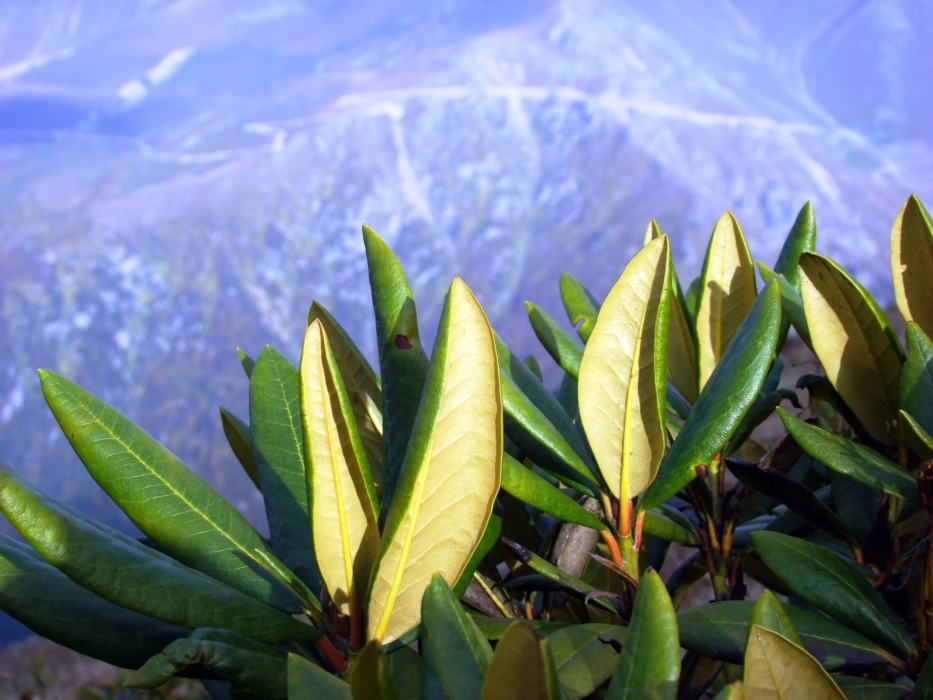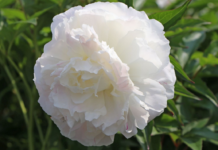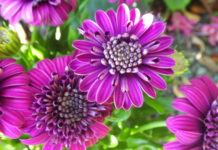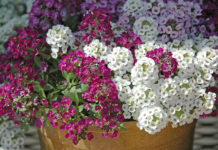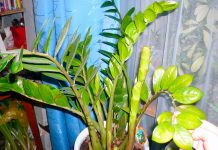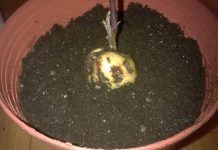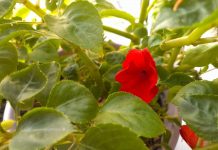Growing a Caucasian rhododendron is easy, given the requirements of a capricious flower. A beautiful plant conquers with a spectacular appearance and useful properties.
Material Content:
Description of Caucasian Rhododendron
Caucasian Rhododendron is a shrub from the Heather family, which reaches a height of 1-1.5 m. Type Description:
- the stem is dark, the length of the shoots increases annually by 3-5 cm;
- leaflets are oval, with a pubescence of a red color on the lower side. Do not fall in the fall;
- inflorescences-umbrellas with a diameter of about 3 cm are white, light pink and light cream color.
Flowers appear on a plant older than 12 years of age in May. The pharynx is yellowish, with a speck of green or red color. Caucasian rhododendron blooms until June. Sometimes in November, reddish box-shaped fruits of an elongated shape are formed. Under favorable conditions, repeated flowering is observed in October.
In the wild, Caucasian rhododendron grows in the mountains of the Caucasus, Krasnodar Territory and Turkey at an altitude of 1.6 -3 km. It can be found in the Kabardino-Balkan and Karachay-Cherkess Republics, in Dagestan, Chechnya and Ingushetia. Shrubs cover vast areas of mountain slopes. During the flowering period of rhododendron, such places look very elegant.
A charming plant attracts gardeners. It is used to decorate personal plots, as well as for the manufacture of therapeutic agents. Cultivating wild Caucasian rhododendron is not easy. In horticulture, hybrid forms of the plant are usually used that are better suited to home growing.
Posada in the open ground
You can purchase young copies in a specialized store or nursery. Propagate and independently propagate the flower. He does not tolerate transplantation, so the place for growing is chosen carefully.
Rhododendrons prefer to grow in partial shade. In sunny areas, burns may occur on leaves and stems. Sometimes flower buds suffer. Especially often, sunburn occurs with significant changes in weather conditions and temperature extremes. For example, when warming comes after severe frosts, the sun begins to shine brightly. With severe shading, the bushes suffer from a lack of sunlight, bloom worse. There is an elongation of the internodes, more often fungal infections are activated.
The composition of the soil makes special demands. The plant will appreciate light, well-drained soil with high nutritional properties. He will like the acidic substrate. Due to a lack of nitrogen, growth slows down, the leaves acquire a light shade. Salt accumulates in neutral and alkaline soils. On heavy soil with a large amount of clay, soaking is more often observed. At the first signs of chlorosis, nitrogen fertilizing is necessary, especially on sandy soils.
The plant resumes growth when the temperature rises above 0 ° C. Planting it in open ground is necessary in April-May, depending on weather conditions. The size of the landing pit is regulated depending on the dimensions of the rhododendron. With a high occurrence of groundwater, drainage is necessary. The root neck in the process is not deepened.
In the first year after planting, the flower is not fertilized. Watering is carried out depending on the weather, do not overdry. Be sure to shelter a young plant for the winter.
Agrotechnics of cultivation and care
Cultivation Features:
- Watering. Moisturize the Caucasian rhododendron sparingly. Excess water provokes disease. In the absence of natural precipitation in the fall before frosts, it is necessary to carry out water-charging irrigation. With a lack of moisture in the winter, the risk of freezing increases, more often winter and spring drying of plants is observed.
- Loosely soil. The procedures are carried out carefully, in an evergreen shrub, the root system is small and located shallow.
- Feeding moderately. At the end of the growing season, fertilizing is not recommended. Late dressings provoke the growth of new shoots, increase the risk of freezing.
- In winter, the bushes suffer a temperature drop of -29 ° C, but shelter is required. It is appropriate to use small branches, spruce branches, dry leaves.
After snowfalls in light frost, it is necessary to shake off wet snow in order to prevent breakage of branches.
Breeding methods
A new plant can be obtained in various ways:
- Layering. It is necessary to dig a shoot located close to the surface of the soil next to the mother liquor. Over time, it will grow stronger and acquire its own root system. Plant a grown plant. Try to move a young bush with a large lump of earth to increase the survival rate of rhododendron.
- The seeds. In the fall, collect ripened seed material. In the spring, fill small containers with acidic soil. It remains to sow, water and wait. The first seedlings will appear only after 2-3 years, so this reproduction is considered quite time-consuming.
- Cuttings. Healthy apical shoots are carefully cut in the fall, after flowering. In winter, they are placed in the soil, regularly watered. In spring, rooted specimens are transferred to open ground in a permanent place.
Reproduction of rhododendron of varietal varieties is carried out only vegetatively - by layering or cuttings. Plants grown from seeds can lose the properties of the mother liquor. For example, the color of pink-flowered specimens may change, or the flower will become less resistant to disease.
Pest and Disease Control
With proper care, plants successfully resist pests and rarely get sick. Excess moisture in the soil, contaminated soil, insufficient aeration of the substrate can cause various problems:
- The first signs of late blight of the roots is the withering of individual leaves on some branches with sufficient watering. Over time, the number of damaged areas increases, leaf blades turn yellow. Brown spots with spores of the fungus are observed near the root neck. The roots change color and rot. At the first signs of a lesion, they are sprayed with drugs based on Bordeaux fluid.
- Symptom of trazeomycotic wilt - the roots turn brown, rot. Gradually, food ceases to flow into the ground. The tops of the shoots dry out and also become brown. Leaves fall, and the whitish-gray color of mycelium spreads more and more. Infected plants must be burned. For prevention, shrubs are treated with fungicide, for example, Fundazol.
- Large round growths on the roots and root neck are a sign of bacterial cancer. Sick specimens grow worse and bloom, with a severe defeat they can die. For minor injuries treated with Bordeaux liquid. If the plant is badly damaged, it is dug up with roots and burned.
- Symptoms of gray rot are dark spots on buds and flowers. The infected areas dry out, a fluffy grayish coating appears on them. To prevent the disease, the plant is sprayed with Fundazol.
Shrubs can suffer from harmful insects - spider mites, thrips, weevils, false shields, whiteflies, bugs. At the first sign of an attack, pests are treated with an acaricide or insecticide, depending on the problem. Typically, spraying is performed several times with a weekly break to completely get rid of small enemies.
The healing properties of the evergreen shrub
Rhododendron contains vitamins, organic acids, many tannins, sugar compounds, essential oils, which possess:
- anti-inflammatory and antiseptic abilities;
- soothing and antipyretic effect;
- diuretic, diaphoretic and fat-burning properties.
The plant is used in folk and traditional medicine. It is a good honey plant. From rhododendron make decoctions, tinctures, various teas, infusions. Here are the problems they should be used for:
- cardiovascular and viral diseases;
- excess weight and diarrhea;
- insomnia;
- mercury poisoning;
- bleeding gums, stomatitis, periodontal disease;
- headaches and neurosis;
- bronchitis, tonsillitis;
- infertility and inflammation in women;
- rheumatism and osteochondrosis;
- stab.
Preparations made from rhododendron increase immunity, help remove heavy metals from the body, and normalize blood pressure. They are used to accelerate the healing of wounds and abrasions, to cope with pustules on the skin.
Rhododendron contains potent toxic compounds that are dangerous to humans. Use plant-based products with caution. Independently increase the dose and the treatment period is unacceptable. Only in this case will the healing properties of the flower appear. One of the toxic substances in its composition is andromedotoxin. Small portions of this chemical compound have a calming effect, but an overdose can cause serious poisoning. You can not use funds from rhododendron during pregnancy and lactation, with a tendency to allergic reactions, problems with the kidneys and liver. Even in the absence of contraindications, it is necessary to consult a doctor before a treatment course.
Caucasian rhododendron will appeal to fans of catchy plants with character. He will delight at any time of the year: in summer - with bright inflorescences, in winter - evergreen foliage covered with felt.


